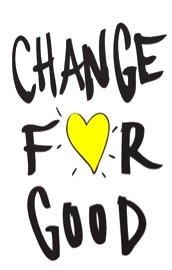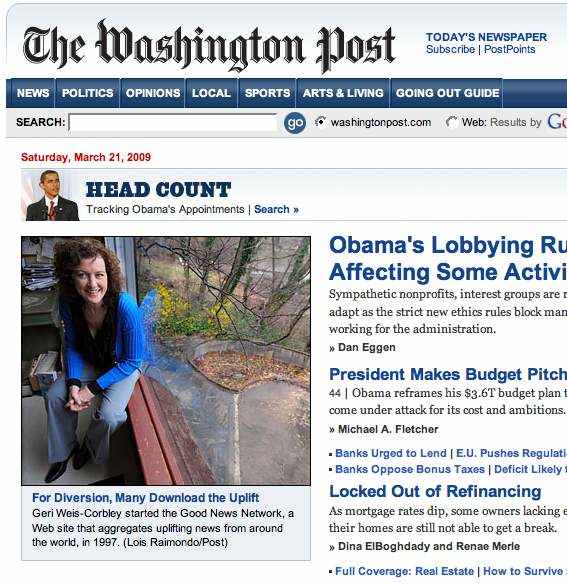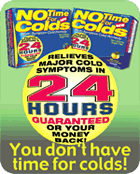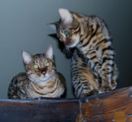Whatever is true, whatever is noble, whatever is right, whatever is pure, whatever is lovely, whatever is admirable — if anything is excellent or praiseworthy — think about these things.
Washington Post ombudsman thinks about their impact
Are we supposed to be boosters or promoters? What are we supposed to be? Not destroyers of community; not extinguishers of hope. We need to think about our impact. We tend to say we don’t have one; we just pass along the news. Readers say otherwise.
Mark Gerzon
A media diet of hostility, blame, confrontation and violence corrodes your civic outlook.
Norman Cousins
If news is not really news unless it is bad news, it may be difficult to claim we are an informed nation.
Marianne Williamson
I think the press, including TV journalism, has an ethical responsibility, a sacred responsibility, a service mission … to make good news just as entertaining (as we’ve made sexy the violence).
Colin Powell
Thank you for writing your newsletter, Some Good News! I enjoyed reading the positive stories … I am heartened by the goodness and generosity that I see in people … Keep up your good work.
Heroes for Danny
Everyone could use a helping hand every once in a while, and for Danny Harkins, this was a perfect time for a helping hand. Without the three boys there to help, he could have died. Thankfully, some people are kind enough to watch out for one another and keep everyone safe. . . Check out the picture of Danny hugging his heroes!
Small Migrant Group Wins Fairer Treatment
Farm Laborers Win Fairer Wages, Protections from Fast Food Company
 Even though this story is nearly eight months old, it is a tale worth retelling. The little guy, a small coalition of migrant farm workers, persisted, pressuring for two years until finally persuasion wins over Goliath. When any group takes a stand with integrity, it is an inspiring story. NPR’s All Things Considered reports on a small farm laborers’ group, the Coalition of Immokalee Workers, who won a surprising victory against the world’s second-largest fast-food company.
Even though this story is nearly eight months old, it is a tale worth retelling. The little guy, a small coalition of migrant farm workers, persisted, pressuring for two years until finally persuasion wins over Goliath. When any group takes a stand with integrity, it is an inspiring story. NPR’s All Things Considered reports on a small farm laborers’ group, the Coalition of Immokalee Workers, who won a surprising victory against the world’s second-largest fast-food company.
Preemies Succeed Despite Challenges
A study in the Journal of the American Medical Association showed extremely low birth-weight infants attained similar levels of education, employment and independence as young adults compared to normal birth-weight infants. Despite challenges including cerebral palsy, blindness, mental impairment and autism, if they get help in school, especially early on, and support through their early school years, “many of them do overcome learning disabilities or any other problem they might have.” WTVD-TV Raleigh/Durham featured this encouraging report about premature babies.
Why Good News? Counting the Benefits
 Good news is often considered too soft and unimportant to be valuable in one’s real life. The truth is, good news can create concrete, positive change in any person’s life no matter their background. I’m not talking here about kittens rescued from trees, but compelling stories about humans overcoming tragedy or facing adversity to rescue others.
Good news is often considered too soft and unimportant to be valuable in one’s real life. The truth is, good news can create concrete, positive change in any person’s life no matter their background. I’m not talking here about kittens rescued from trees, but compelling stories about humans overcoming tragedy or facing adversity to rescue others.
Uplifting news, though, is difficult to learn to appreciate for some. The urge to look, rather, to the sensational feels more urgent — popular media having fed the habit for decades. But, it turns out, there is an evolutionary basis for that. Being more aware of possible danger in the bushes was how we survived being eaten by tigers. But scientists now have shown that we can ‘rewire our brains’ to great benefit by resolving to focus on things we appreciate, instead of things we abhor.
In my experience, since I began 25 years ago to refocus my thoughts on the positive, while training myself to release the negative, I’ve experienced less sickness, less misfortune, less loss, less failure, less crime, less fear and futility, while attracting more of all their opposites.
Of course that is anecdotal, but it seems to me that every thought, every feeling, is a magnet, and life delivers exactly a match in return, for better or worse. Many people have experienced this principle. A leading MD and surgeon, now an author and teacher, Dr. Christiane Northrup, calls it the Law of Attraction and says that we create the state of our body by the thoughts we think. “Every thought we think changes our biochemistry. Your hormones are all affected by your thoughts. Pay attention to things that bring you joy. When I read the newspaper, I look for the good news.”
Young people are learning how positive thinking can directly affect performance and happiness. A positive psychology course at Harvard in 2006 was the most popular class on campus with around 850 students enrolled.
For most of us, having been bombarded with negative news for years, it becomes all the more valuable to invest every day in our health, peace, and prosperity by building some habits that reinforce a positive attitude about our world. Joining the Good News Network® is a great first step.
Visiting our Web site is a little like taking a flashlight into a cluttered closet. You begin finding valuable things you didn’t know you were looking for, useful in ways you can’t yet perceive. Additionally, your mind, like the closet, benefits from a good cleaning and rearranging. The benefits good news can bestow on the heart of your real life are compelling. GNN is turning on the lights to help you reap that treasure.
Geri Weis-Corbley
2005 (Updated in 2014)
Image credit: Change for Good/LostDog, iPhone cases
What counts as good news for us?
Criteria for material published on the Good News Network®
First of all, the stories must always be compelling — the opposite of boring.
The subject must also exhibit several of the following characteristics:
- Opposing groups find common ground and move forward together
- Shows compassion or understanding toward others
- Refutes the stereotypes that are regularly applied to any group
- Exhibits love, non-violence, generosity, peaceful conflict resolution, or caring
- Features solutions to problems, while exhibiting the characteristics above
- Exemplifies support for the sustainability of our planet
The Good News Network® publishes news that reflects our values. These are values that are reinforced with every story and commentary.
- Freedom
- Responsibility
- Integrity
- Compassion
- Cooperation
- Generosity
- Equality and oneness
What we stand for
The Good News Network is expressing a philosophy. We believe in striving for cooperation, sustainability, generosity, and unity — and trying in our lives to love. We will share analysis of current affairs and public opinion that reflect this philosophy of optimism, because many, including well-known columnists, are optimistic.
We do not want to polarize with debate but unify upon common ground. We believe the common ground upon which we can find agreement as citizens of the 21st century is based on the traditional seven values listed above.
What we do
We report on outstanding citizen action to offset the daily barrage of negative news. We showcase innovative solutions to the world’s problems.
We feature articles that help to shatter negative stereotypes. We try to uplift our views of government, politicians, the corporate community, the entertainment industry, public schools, inner cities and each other.
The Mission of Good News Network
What we offer
A Daily Dose of News to Enthuse — The Good News Network® is a clearinghouse for the gathering and dissemination of positive news stories from around the globe. Daily stories will confirm what we already believe — that good news itself is not in short supply; the advertising of it is.
Citizens are invited to submit stories to the network. News professionals in the mainstream media may also contribute to GNN-i so that their optimistic news and commentary receives a wider audience and sustained appreciation.
Press Clips and Publicity

CBS Evening News
Katie Couric’s Notebook (Video)
“The Good News Network is devoted to all the good news that’s fit to print… When the headlines seem bleak, it’s nice to know that some really GOOD news is just a mouse click away.”
The Washington Post, March 21, 2009
For Diversion, Many Download the Uplift
“There are other Web sites that aggregate good news from around the world, but few are as current, well kept and newsy as hers. She’s out to prove that good news sells.” — Dan Zak
NPR’s All Things Considered
GoodNewsNetwork: No Gloom, No Doom (4-min audio interview)
“Weis-Corbley thinks an alternative to the grim fare offered by major news outlets is essential. And traffic is up.” — Michelle Norris
 WTOP Radio
WTOP Radio
Good News is Good For You
Toronto Globe and Mail
Recession Got You Down? C’mon Get Happy
“It has taken a financial crisis to spur an appetite for good news.” — Omar El Akkad
Rolling Stone
Featured on the magazine’s 2009 Hot List – Hot Internet (p. 89)
Communicate GOOD 2013
Talking Good With Geri Weis-Corbley
The Examiner
Good News For a Change
Info Today
What We Need Is Some Good News
Daily Nebraskan
Internet site brings good news to a dismal world
“After reading headlines about the terrible condition of humanity, take some time to challenge those observations by reading about the unexpected at goodnewsnetwork.org. It could do wonders for your psyche.” — Stacy Van Zuiden
American Journalism Review
It’s All Good
“One of her goals is to show that there is actually a hungry market for this. The monthly hits she gets on her site act as pretty heavy validation of a demand.” — Tricia C. Eller
Women’s World
Fed Up With Bad News?
“Imagine getting only good news all the time. Geri does more than imagine it – she finds it, prints it, and passes it on! … Geri found stories about heroic rescues and generous gifts, scientists making headway against disease and groups building homes for the poor. She even found a heartwarming story about lawyers — a band of whom are representing low income kids for free in juvenile court. And readers loved it!”
Washington Times
All the Good News that’s Fit to Print
“She’s a cross between Dr. Deepak Chopra and Ann Landers.” — Christin Montgomery
Newsday
“Take Heart America… The Good News Network, is a place on the web where you can go every day to renew your faith in the human race. Since its webut a year ago, GNN has been steadily finding an audience.”
Fox TV Morning Show
Live Interview via satellite with KTVU Ross McGowan in San Francisco
Frederick News Post
“We think we can learn something from Weis-Corbley, not only about how we pay attention, but what we pay attention to. — The Fine Print Op-Ed
Fast Company
Bookmarks
The Well Being Journal
Good News — Bill Asenjo, P.H.D., CRC
Radio Interviews
WBIG- Chicago; CKLW- Windsor; KOTA- Rapids City; “The Daily Bear”; WVMT-Vermont; WTAM; WOCM- Maryland; “The Live Show”- Oklahoma; “Rhonda Bellamy Show”- NC; WRVC- Ohio; WILS-Lansing; “Carter and Company”, “Washington Post Radio” (in drive time), “Mirrors of the Soul”

300 Incredible Things to do on the Internet! (2002 edition)
“I have spent months surfing hundreds of thousands of sites, but only the incredible ones made it into this book. It’s incredible sites like yours that make this a fantastic book.” — Ken Leebow
The Washington Post, Sept. 1, 1999
And now, the news: The Glorifying not the Horrifying
Whole Life Times
Antidote to the Daily Headlines
“Geri’s enthusiasm, humor and selfless efforts personify a message for us all: the good news is there, if we seek it out.” — Bill Asenjo, P.H.D., CRC
________________________________
PRESS RESOURCES
HISTORY of GNN and its publisher, Geri Weis-Corbley
CONTACT – 703.392.4118
Past Press Releases and Publications
April 25, 2006 — New Design for Web site
August 29, 2006 — 9th Anniversary: Daily News Helps Relieve Depression in Viewers
FREE Download of 9/11 Edition of Good News Newsletter (PDF)
Staying Healthy (Naturally) is Smart Science
 Thousands of Americans wrote to a small, but forward-thinking company to say ‘thanks’ for inventing an arthritis treatment that works often when nothing else would: A treatment that is actually healthy for the body, unlike some pharmaceutical drugs with side effects like Vioxx (which was pulled from the market after studies found an increased risk for heart attack and stroke). And now, this same small company can be thanked for bringing what might be the best remedy for the miserable symptoms of the common cold to the U.S. market. In a clinical trial their cold lozenge was shown to significantly reduce major cold symptoms within 24 hours. Unlike the giant pharmaceutical companies, this company, SmartScience Laboratories, believes the prescription for staying healthy doesn’t necessarily come from a doctor. Studies show that if we add the right nutrients to our bodies, the end result is health. That’s just smart. SmartScience.
Thousands of Americans wrote to a small, but forward-thinking company to say ‘thanks’ for inventing an arthritis treatment that works often when nothing else would: A treatment that is actually healthy for the body, unlike some pharmaceutical drugs with side effects like Vioxx (which was pulled from the market after studies found an increased risk for heart attack and stroke). And now, this same small company can be thanked for bringing what might be the best remedy for the miserable symptoms of the common cold to the U.S. market. In a clinical trial their cold lozenge was shown to significantly reduce major cold symptoms within 24 hours. Unlike the giant pharmaceutical companies, this company, SmartScience Laboratories, believes the prescription for staying healthy doesn’t necessarily come from a doctor. Studies show that if we add the right nutrients to our bodies, the end result is health. That’s just smart. SmartScience.
SmartScience Laboratories CEO and founder, Gene Weitz, began his career in Minnesota in the field of chemical engineering but evolved into the realm of nutrition and health; interesting because both fields deal with formulas and their reactions. In the 1980’s Weitz worked for small companies inventing products like lubricants and environmentally friendly solvents and cleaners. In the mid-90’s he was hired to develop nutritionally fortified creams for pain. At about the same time his wife began a grueling experience with fibromyalgia,a mysterious disabling disorder affecting 6 percent of the population. Thus began a personal journey for Weitz during which nutritional healing became deeply imprinted in his personal philosophy.
A nutritional consultant counseled the couple regarding the fibromyalgia. Her advice was to improve the diet (cut out sugars, white flour and white potatoes), add dietary supplements, and do some things that naturally detoxify the body of heavy metals and toxins. “As it turns out,” Gene reported, “She was right, because within six months his wife was 70–80 percent better and within a year, 100 percent better… She’s really never gone back.”
Weitz has had one goal since college, to run a successful company. By February 1998, acting out of an inspiration to improve the lives of others by creating helpful over-the-counter products for consumers, he’d acquired the rights from his old partner to use some of the formulas he’d developed. He now improved the topical cream, adding camphor and nutrients to provide additional benefit. SmartScience Laboratories was born.
Weitz explains: “Most testimonials tell us how they have tried nearly everything to relieve their pain including prescription drugs, oral pain relievers, physical therapy, other topical pain relievers and even getting shots, yet they received little or no results. But when they tried JointFlex, they got unexpected, substantial pain relief and many became completely pain free!”
JointFlex has been shown in clinical studies to offer substantial immediate pain relief for chronic sufferers of osteoarthritis pain. Even more amazing, Weitz said, was that “Almost one third of the people in the study ELIMINATED their pain with continued daily use of the JointFlex cream. Their pain scores were down to zero. These were people who suffered from chronic arthritis pain for ten years or more. “They now have a safe, effective and inexpensive alternative to prescription and other non-prescription drugs.”
JointFlex uses a trade secret technology Weitz invented called FUSOME. Fusome technology uses little beads; creating little micro-spheres of ingredients that appear to penetrate deeply within the skin. And what happens from there? “We haven’t proven that yet… other than we know we’re getting excellent pain relief. That’s where the magic really starts to happen.”
SmartScience wants to provide more products, like JointFlex, that use the safest ingredients available and provide the user with exceptional benefit. That’s really what they’ve done with their newest offering, No Time For Colds.
“We’ve taken a (FDA-labeled) homeopathic active ingredient which is the zinc gluconate, that has been used quite prevalently and is very safe, and we’ve added a new active ingredient, a naturally occurring herb, which is the bioflavonoid. No Time for Colds has been shown to offer relief from major cold symptoms in 24 hours. So that’s one of the reasons I fell in love with this product… it matched my business model and my business philosophy.”
The product was developed in Denmark and has been marketed in Scandinavia for two years. “It’s just been phenomenally successful over there,” reports Weitz.
 No Time for Colds sets a new precedent with the addition of the bioflavonoids. The lead investigator of the clinical trial at the University of Virginia’s School of Medicine, Ronald B. Turner, says, “A clinically relevant and statistically significant reduction in clinical symptoms of the common cold occurred within 24 hours when using No Time for Colds.”
No Time for Colds sets a new precedent with the addition of the bioflavonoids. The lead investigator of the clinical trial at the University of Virginia’s School of Medicine, Ronald B. Turner, says, “A clinically relevant and statistically significant reduction in clinical symptoms of the common cold occurred within 24 hours when using No Time for Colds.”
The remedy is also is safe for kids aged four and up. It tastes decent too, in cherry or lemon flavors, so parents won’t need to assume battle positions to get their kids to take it. Also beneficial is the fact that it is sugar-free, gluten-free, and lactose-free. SmartScience is so confident of the effectiveness of No Time for Colds they are extending their money-back no-questions-asked guarantee.
Big question: Aren’t cold symptoms simply our body’s necessary means of flushing out a virus? “No,” explains Mr. Weitz. “People think, ‘Wow, the body must need to flush this virus out. My nose is running like a faucet.’ But, runny nose, malaise and headache, are immune system OVER-responses to the common cold virus that DO NOT prevent the virus from running its normal course. These responses to the cold serve no purpose that is beneficial. The body is just wasting energy. Viruses multiply within the cells so flushing it out doesn’t work. We all assumed it was the body just doing what it needed to do. But most colds are from the Rhinovirus which is absorbed through the mucus area and nasal area. That’s how they attack the body. No wonder they go crazy first.”
SmartScience Laboratories manufactures No Time for Colds in the U.S. and with their distribution network of 30,000 major drug stores and chains they can offer it widely to consumers along with JointFlex. A store locator is available on the No Time for Colds Web site.
What is next for SmartScience? Weitz is not certain, but judging from their philosophy we can expect products based on a simple principle: Providing effective alternatives to prescription drugs and remedies that have negative side effects. Safe products that work. Smart!
Swim Team Gives Back Trophy After Discovering Error
 Augusta, Georgia swim coaches Kevin Skenes and Alex Trakowski were honored for returning their trophy after discovering and pointing out a scoring error that cost their team the Division 4 championship.
Augusta, Georgia swim coaches Kevin Skenes and Alex Trakowski were honored for returning their trophy after discovering and pointing out a scoring error that cost their team the Division 4 championship.
At a year-ending all-star game, amid a standing ovation, league officials awarded plaques to the two men calling them “champions of integrity, honesty and sportsmanship.”
(Source: Augusta Chronicle, “A True Lesson in Honesty,” July 12, 2005)
GE Is Going Green
 The CEO of America’s biggest corporation did something astonishing this week: He staked his company’s future on its ability, in his words, “to define the cutting edge in cleaner power and environmental technology.”
The CEO of America’s biggest corporation did something astonishing this week: He staked his company’s future on its ability, in his words, “to define the cutting edge in cleaner power and environmental technology.”
The greening of General Electric was announced by its chief executive, Jeffrey Immelt. He said that by 2010, GE would double its research spending on cleaner technologies to $1.5 billion annually and double its sales of environment-friendly products to $20 billion annually. Meanwhile, GE will reduce its own emission of greenhouse gases by 1 percent by 2012; without this action, emissions would have increased 40 percent. The company is promoting this effort with the infelicitous slogan, “Ecomagination,” but that’s about the only thing wrong with it.
GE is a corporate bellwether. It has a market capitalization of $381 billion and is the most widely held stock in the world. Its former CEO, Jack Welch (who recently published a book with the very un-green title, “Winning”), was a symbol of the management style of the 1990s, which emphasized shareholder value above all else. Immelt made himself a symbol this week of a new CEO style that emphasizes a company’s obligation to a range of stakeholders, including the global environment.
The GE announcement is the most dramatic example yet of a green revolution that is quietly transforming global business. We tend not to see it clearly in the United States, in part because the Bush administration opted out of the Kyoto protocol that took effect in more than 140 countries in February. But if you’re GE and you do billions of dollars of business in Europe (where all 25 members of the European Union ratified Kyoto) you already have to comply with global environmental policies, regardless of what the Bush administration says. What Immelt did, in essence, was to apply the rules that shape GE’s operations abroad to the company as a whole.
What’s happening is that policy on the environment and many other key social issues is being privatized. Informal networks are emerging that link influential nongovernment organizations, giant corporations and governments that want to solve social problems. These networks develop new rules that become industry standards. The United States may drag its heels or criticize these efforts, but its public naysaying is becoming irrelevant to the process of change.
A good example of these self-enforcing rules is an environmental benchmark for financial institutions, known as “The Equator Principles.” Participating companies agree not to lend money for a project unless the borrower completes a detailed environmental assessment that explains how it will meet criteria for sustainable development and other social goals. These principles have now been adopted by nearly all the major global financial institutions, including Citigroup, Bank of America, HSBC and JPMorgan Chase.
Nobody wants to be the next General Motors, the once-mighty automaker that was reduced last week to junk-bond status. GM bet its future on fuel-wasting SUVs and small trucks, even as Toyota was betting that the world would want cars with lower fuel consumption and reduced emissions. Today, Toyota can’t make enough of its fuel-saving hybrid car, the Prius.
The green revolution is partly defensive. In an era of corporate scandals symbolized by the Enron debacle, CEOs understand that their brands are precious equity. To maintain trust in a brand, it isn’t enough anymore to make good products. Consumers trust companies that are responsible citizens; they mistrust companies that appear selfish or wasteful.
The changes announced by GE and other companies are partly cosmetic — a bid for better PR — but maybe that’s the point. These days, you have to be seen as doing good to do well. As Immelt put it this week, “green is green.”
David Ignatius is a syndicated writer in Washington, D.C. – (printed with kind permission)
Integrity in Professional Sports is Not Dead
 This is one of my favorite stories from last year. I want to make sure you know about the integrity of professional tennis player, Andy Roddick…
This is one of my favorite stories from last year. I want to make sure you know about the integrity of professional tennis player, Andy Roddick…
The top-ranked player in the Rome Masters tennis tournament, American Andy Roddick, disputed an umpire’s call IN FAVOR OF HIS OPPONENT! He lost the match because of his stroke of honesty. “On the Mark” over at the blog, Toner Mishap, Tipped his hat to Andy back in May:
Positive Earth Facts from 2003
 Non-Toxic Products
Non-Toxic Products
Chemical Specialties Inc. is successfully launching its arsenic-free wood preservative into the commercial marketplace. A mixture of copper and quat — a commonly used disinfectant — ACQ-Preserve is predicted to spur an industry-wide phaseout of toxic, arsenic-laden preservatives typically found in lumber sold to home builders and hardware stores.
2003 Salmon Run Bountiful at Last
 For the first time in 38 years, American Indians on Oregon’s Columbia River have harvested a surplus of summer chinook salmon. 120,000 salmon are making the summer run upriver, compared to only 15,000 in the mid-1990’s, the second-highest rate since 1960. The return of unusually abundant chinook, each weighing 20-30 pounds and fetching $2 per pound, is due to several factors, including improved habitat, the nutrient level of the water, hatchery operations, and harvest management.
For the first time in 38 years, American Indians on Oregon’s Columbia River have harvested a surplus of summer chinook salmon. 120,000 salmon are making the summer run upriver, compared to only 15,000 in the mid-1990’s, the second-highest rate since 1960. The return of unusually abundant chinook, each weighing 20-30 pounds and fetching $2 per pound, is due to several factors, including improved habitat, the nutrient level of the water, hatchery operations, and harvest management.




















